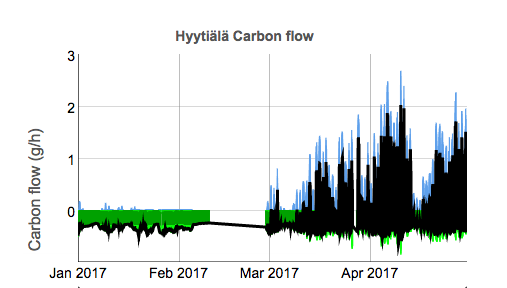
Impact of Snow on Soil Greenhouse Gases
Spring is finally in the air, and while the thermometers are slowly but steadily rising, we wanted to explore the impacts of the exceptionally snowy winter on the soil’s greenhouse gas emissions. For this post, we interviewed a researcher, Boris Tupek, who is based in Luke, the Natural Resources Institute Finland.
Tupek’s research specializes in greenhouse gases, including measuring and modeling of CO2, CH4, N2O (carbon dioxide, methane and nitrous oxide, commonly known as laughing gas) in forests and peatlands and their interface, and modeling carbon capture in European forests, testing widely used soil carbon models with extensive datasets in Sweden, Finland, and Ethiopia.
Like Gasmet, the studies he is involved in aim to curb climate change by gaining a better understanding of the controls of processes of greenhouse gas exchange. The understanding of controls helps improve the models and methods used for the annual reporting of greenhouse gas changes to UNFCCC (United Nations Framework Convention on Climate Change) as well as local soil management.
Cold Winter and Heavy Snowfall Limit Soil Greenhouse Gases
In normal winter circumstances, the cold temperatures limit microbial activity and keep the soil’s greenhouse gas emissions low.
Early or late start of the growing season can determine whether the annual ecosystem CO2 exchange will be a carbon sink or source – for example, carbon sinks are natural environments, such as forests, oceans or soils, viewed in terms of their ability to absorb carbon dioxide from the atmosphere. Carbon sources, in turn, include emissions from burning fossil fuels, forest fires, and respiration.
For example, freezing temperatures in November and heavy snowdrifts favor the carbon sink, but late snowfall in spring may reduce the growing season in favor of the source, and vice versa. Tupek points out that early sunshine in spring activates photosynthesis in trees, which naturally increases the carbon capture from the atmosphere, and naturally decreases the carbon dioxide levels.
Current Soil Greenhouse Gas Emissions and Future Forecasts
A research group that studied the air concentrations of Antarctic snow layers found out that there has been a drastic increase in the HFC-23 in the past 100 years. HFC-23 is a greenhouse gas that can trap thousands of times more heat than a similar amount of the better-known greenhouse gas, carbon dioxide.
This does not paint a very optimistic view on the horizon, but according to Tupek, the current situation in Finland is good. He does, however, point out that considering the low temperatures of the past winter with an abundance of snow and sunshine, the recent snowmelt and sudden heatwave might contribute to the forests gaining more carbon than in previous years.
He continues that there is also a loose link between CO2 and CH4, carbon dioxide and methane. Methane increases with temperature by activating microbes and with photosynthesis by plants, supplying microbes with fresh sugars. However, methane emissions are restricted only to permanently wet ecosystems such as mires or peatlands, and compared to carbon dioxide soil methane emissions are much lower.
The forecasts for future winters are not so optimistic: we will have less continuous snow cover and increased rain in the winter. Soils respire more CO2 when not frozen and trees uptake less CO2 by photosynthesis with less sunshine, which will lead to increased greenhouse gas emissions during warm winters. However, high emission levels caused by warm winters might improve by earlier plant growth and increased photosynthesis in spring, Tupek explains.


Spring Recovery of photosynthesis in 2018 and 2017. Source: Carbon Tree by Helsinki University
Research Plays a Vital Role in Understanding Greenhouse Gases and Climate Change
There is no easy fix to the mostly human-induced global warming, but research can offer valuable aid to help understand the processes, controls, and feedback of climate change.
Science and research have also helped understand the major players in greenhouse gas balance and acts as an advisory to governmental decision-making. For example, the action guidelines of the Intergovernmental Panel on Climate Change (IPCC) to mitigate climate change are motivated by the scientifically objective view of climate change.
Tupek states that it is vital that we focus on the soil greenhouse gas sinks and sources in the system – and more importantly, look into influencing them in such a way that we develop the sinks and reduce the sources.
3 Simple but Effective Ways to Mitigate Global Warming:
- Reducing or replacing the combustion of fossil fuels by the use of renewable energy
The agricultural and forest soils have great potential for continuous carbon sink under the right management decisions. For example, the 4 per 1000 (4 per mil) initiative aims to slow down the atmospheric CO2 increase by increasing global soil organic carbon stocks by 0.4 % annually. - As obvious as it sounds, planting trees is a great way to naturally manage the carbon sinks.
- Reducing greenhouse gas emissions starts at an individual level
Implementing measures to mitigate climate change is the task for the whole human race, but it starts with human individuals. It’s our day-to-day decisions that matter – whether it’s using more daylight in offices instead of bulbs, or traveling by public transport or bicycles instead of cars.
| Greenhouse gas flux measurements
The measurement of GHGs from soil represents an important part of climate change research. GHGs, such as Carbon Dioxide (CO2), Methane (CH4) and Nitrous Oxide (N2O), released from soils into the atmosphere are primarily biogenic by origin. Learn more about our solution for measuring greenhouse gases from soil |
 |
